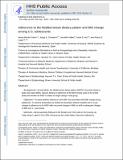| dc.contributor.author | Martin-Calvo, Nerea | en_US |
| dc.contributor.author | Chavarro, Jorge E. | en_US |
| dc.contributor.author | Falbe, Jennifer | en_US |
| dc.contributor.author | Hu, Frank B. | en_US |
| dc.contributor.author | Field, Alison E. | en_US |
| dc.date.accessioned | 2016-11-18T20:48:47Z | |
| dc.date.issued | 2016 | en_US |
| dc.identifier.citation | Martin-Calvo, Nerea, Jorge E. Chavarro, Jennifer Falbe, Frank B. Hu, and Alison E. Field. 2016. “Adherence to the Mediterranean dietary pattern and BMI change among U.S. adolescents.” International journal of obesity (2005) 40 (7): 1103-1108. doi:10.1038/ijo.2016.59. http://dx.doi.org/10.1038/ijo.2016.59. | en |
| dc.identifier.issn | 0307-0565 | en |
| dc.identifier.uri | http://nrs.harvard.edu/urn-3:HUL.InstRepos:29408436 | |
| dc.description.abstract | Background: Among adults, the Mediterranean dietary pattern (MDP) is inversely related to body mass index (BMI). Data are lacking on adherence to the MDP among youth in the United States and whether the MDP is related to weight change in that group. Objective: To assess whether adherence to the MDP was associated with BMI change among adolescents. To examine temporality we studied the association between baseline and 2–3 year changes in adherence to the MDP with concurrent changes in BMI, as well as subsequent changes in BMI over a 7-year period. Methods: We prospectively followed 6 002 females and 4 916 males in the Growing Up Today Study 2, aged 8–15 in 2004, living across the United States. Data were collected by questionnaire in 2004, 2006, 2008, and 2011. Dietary intake was assessed by the Youth/Adolescent Questionnaire. The KidMed Index was derived to measure the adherence to the MDP. We used generalized estimating equations with repeated measures within subjects to assess the association between MDP and BMI change. Results: A two-point increment in the KidMed Index was independently associated with a lower gain in BMI (−0.04 kg/m2; p=0.001). A greater increase in adherence to the KidMed Index was independently related to a lower gain in BMI in both the concurrent (p-for-trend<0.001) and the subsequent period (p-for-trend=0.002). Conclusions: Adherence to MDP was inversely associated with change in BMI among adolescents. 2-year improvement in adherence to MDP was independently associated with less steep gain in the BMI in both the concurrent and the subsequent period. | en |
| dc.language.iso | en_US | en |
| dc.relation.isversionof | doi:10.1038/ijo.2016.59 | en |
| dc.relation.hasversion | http://www.ncbi.nlm.nih.gov/pmc/articles/PMC4935550/pdf/ | en |
| dash.license | LAA | en_US |
| dc.title | Adherence to the Mediterranean dietary pattern and BMI change among U.S. adolescents | en |
| dc.type | Journal Article | en_US |
| dc.description.version | Version of Record | en |
| dc.relation.journal | International journal of obesity (2005) | en |
| dash.depositing.author | Chavarro, Jorge E. | en_US |
| dc.date.available | 2016-11-18T20:48:47Z | |
| dc.identifier.doi | 10.1038/ijo.2016.59 | * |
| dash.contributor.affiliated | Chavarro, Jorge | |
| dash.contributor.affiliated | Hu, Frank | |


